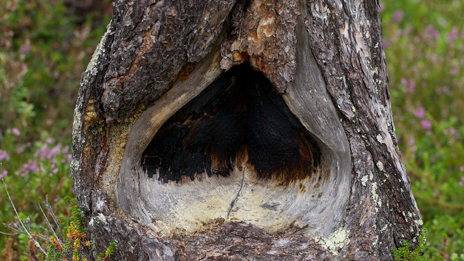 Pine scarred by fire. Photo: Naturcentrum AB.
Pine scarred by fire. Photo: Naturcentrum AB.
Forest fire
In the days before rapid-response fire services, a stroke of lightning could quickly develop into an extensive forest fire. Some dry summers were notorious for forest fires, and large areas of the coniferous forest belt were affected.
Many animals and plants have adapted to recurring fires. Pine is one of these. Thanks to its tall crown and thick bark, it usually survives a fire. In Gränslandet you can see traces of fire on old trees and stumps. Research in Gutulia National Park has shown that there have been four fires since the 18th century; in 1700, 1720, 1800 and 1860. There have also been fires in many other parts of Gränslandet, but the numerous lakes, streams and bouldery fells have limited their spread.
Why the fire fighters didn’t put out the fire
In 2009, there were three fires in Femundsmarka National Park. They were left to burn themselves out, to let nature take its course. The fire authorities supervised the fire to ensure that there was no risk to people or buildings. If you want to see how life returns after a fire, visit the forest fire area to the west of Reva.





